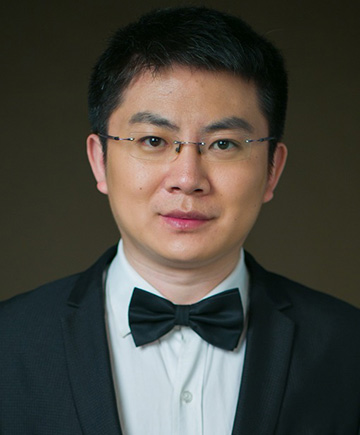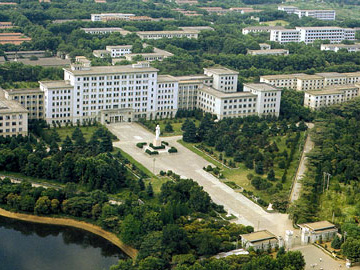
Jian Wang
OPN has been talking with members of the optics and photonics community in a variety of areas to get their perspective on how the COVID-19 crisis has affected their lives and work, and what the pandemic means for photonics. On 21 April, in an email exchange with OPN, OSA Senior Member Jian Wang, a professor at Huazhong University of Science and Technology in Wuhan, China, offered his own thoughts on the pandemic’s impacts there, and how Wuhan is now attempting to recover.
I understand that Wuhan is considered China’s “Optics Valley.” Could you talk a bit about the concentration of optics and photonics in this area?
Yes, Wuhan is considered China’s Optics Valley … It now has 42 colleges and universities, 56 national and provincial scientific research institutes, more than 1,800 “Internet+” companies, more than 200,000 technicians, and one million undergraduate students. Wuhan also has China’s only national laboratory in the field of optoelectronics, the Wuhan National Laboratory for Optoelectronics (WNLO) at the Huazhong University of Science and Technology (HUST).
Wuhan has established the largest production base of optical fiber, optical-fiber cables and optoelectronic devices; the largest R&D base of optical communications; the largest laser industry base; and the largest geospatial information industry base. The domestic market share of optical-fiber cables, optoelectronic devices, and lasers is more than 60%, and the international market share is 25%. Meanwhile, important breakthroughs have been made in lots of emerging areas—integrated circuits, new displays, memory devices and mobile internet …
What is your own role at HUST, and what areas does your work emphasize?
I received my Ph.D. in physical electronics from WNLO in 2008. Then I worked as a postdoctoral research associate in the Optical Communications Laboratory, University of Southern California, USA, from 2009 to 2011.
I’m currently a professor at WLNO and director of the department of Optoelectronic Devices and Integration (OEDI) there. I lead the Multi-Dimensional Photonics Laboratory (MDPL). My research interests include optical communications, optical signal processing, silicon photonics, photonic integration, orbital angular momentum and structured light.
In addition to being China’s Optics Valley, Wuhan was also, of course, an important early “hot spot” in the emergence of COVID-19. Could you talk about when you first heard about this coronavirus?
Although COVID-19 had been reported even earlier, I personally first heard about this and started paying enough attention to it on 20 January 2020. I got this news from the webpage of my cellphone. Nanshan Zhong—the leader of the high-level expert group of the National Health Commission in China, an academician of the Chinese Academy of Engineering, and a famous respiratory expert—was interviewed by the media on a series of issues related to COVID-19.
He said that COVID-19 was confirmed to be transmitted by humans. I think this was a very important turning point. After that, people began to get nervous, and our daily life began to change.
How did the government’s lockdown unfold after that? How did it affect your ability to work, and how did you and your colleagues adapt?
![]()
[Image: Alessia Kirkland]
On 23 January 2020, Wuhan city was closed, to cut off the source of infection and prevent COVID-19 from spreading to the whole country. This brought great inconvenience to people’s daily life. I personally just stayed at home with my family … Since it was during the Chinese New Year holidays, most of my colleagues were on vacation. We did not go to work in the first one to two weeks after the government’s lockdown.
After that, of course, we had to adjust our way of working, and try to adapt to the norm of working at home.
We have heard from a number of people in other regions that one thing that they had to learn quickly was how to do online teaching/learning. How was that challenge handed by your department?
Actually, online teaching and learning have been easy for us, as the internet in China is now very developed. We are used to online conference meetings. Also, a lot of free online meeting software became available after COVID-19, so it is easy for us to organize the meetings with our colleagues and our students.
I personally have one to two meetings every day, including the department’s meeting, group meeting, academic meeting, etc. Our department also organizes online thesis defenses and career guidance discussions.
Teaching online is now very popular all over the country, ranging from university to high/junior/primary school, even kindergarten. My daughter is now having online class organized by the kindergarten. I also plan to organize an online international academic seminar between my group and another group abroad. One challenge will be to guarantee the high network connection speed.
I personally believe more and more online activities will emerge after COVID-19. The 5G technology, currently in deployment, will definitely play an important role.
What about the research/lab side of your work?
It is certain that COVID-19 has caused a great impact on our lives and work—including my own research and lab. Since 23 January 2019, our university, including my lab, has been closed. Our students were advised to stay at home. All experimental work—fabrication of optoelectronic devices, experiments of optical communications, etc.—stopped.
We have adapted to this by moving our recent research focus to theory and simulations. We have more time to read papers, write papers and have brainstorming meetings. You cannot do experiments, but you still have lots of things you can do if you want. So I personally think we can reduce the impact to the minimum by appropriately adjusting our work plan and focus.
How did the crisis and lockdown affect things like planning research funding and personnel?
The crisis and lockdown have mainly caused the delay of lots of things. For example, we can still apply online for research funding—but with almost a one-month delay. Almost all things like planning research funding and personnel can be done online without paperwork, so the impact is limited. Despite the delay, everything still moves on.
We’re now seeing interesting news about activity starting up again in Wuhan. What can you tell us about this “re-start” and how it’s going?
That’s true—the re-start of Wuhan is indeed good news, and also, I believe, exciting news for the whole world under COVID-19. It represents a stage in the success of the battle against COVID-19.

Huazhong University of Science and Technology, Wuhan, China. [Image: Wikimedia Commons / CC-By-SA 3.0]
In my experience, I have to say that our government has done a great thing and has taken decisive and effective measures to quickly control COVID-19. The results tell us everything. Our university has also done a lot of work to ensure the safety of teachers and students. After the re-start, we are first seeing the resumption of activity in large industrial firms. You may also have noted the removal of restrictions on outbound travel on 8 April 2020.
After that, Wuhan started to recover slowly. People outside of Wuhan began to return. Small companies, markets, enterprises and institutions also began to return to normal. School administrators and teachers began to return to work. Students will also return to school soon, in batches. All of these things are exciting, although more time will still be needed for a full recovery.
Are there specific rules related to the re-start of activity in Wuhan—for example, to try to prevent a re-spread of the virus?
Yes. Even with the return to work, production and school, the whole society, including Wuhan, has been paying great attention to the prevention and control of COVID-19.
The good thing is most people fully understand this after experiencing COVID-19. There are lots of specific rules to prevent a re-spread of the virus. For example, people are advised to keep staying at home, keep social distance and wear masks in public. Large parties and events are not encouraged. We see notices and receive reminders everywhere to prevent COVID-19.
The whole society is also strengthening its examination of asymptomatic infection. Physical examinations and nucleic-acid testing are encouraged before returning to work, production and school.
Given how hard Wuhan was hit by this virus, I’m wondering if there might be some reluctance to return to life as it was.
It is true that some people in Wuhan are still nervous after the re-start. This is understandable, as people in Wuhan have suffered serious physical and mental trauma from COVID-19 in the past months.
The government is now encouraging people to consume and helping people regain the confidence. It will take some time, and I do believe everything will go well soon. I believe that for the people in Wuhan, the darkest period has passed, and tomorrow will be as good as ever.
What about the larger picture of optics and optoelectronics in Wuhan? How has the lockdown affected activity?
Personally, I think the larger picture of optics and optoelectronics in Wuhan will be “Wuhan—World Optics Valley,” similar to the Silicon Valley in the United States. The lockdown pressed the “Pause” key temporarily, and after the re-start, activities will recover slowly.
To bring research and industrial activity in optics back up to speed in the wake of the disruption, I personally believe three things are needed: city functions need to be repaired first, so that research and industrial activity in optics can quickly return to normal; more preferential policies are needed to support small- and medium-size enterprises of optics and optoelectronics; and more appealing initiatives are needed to attract graduates to stay in Wuhan and build Wuhan.
Actually, our government has launched many new measures to promote economic growth and ensure employment. Everything has two sides … People in China will be more united after COVID-19. I do believe everything in Wuhan, including Optics Valley, will go well and even better with the hard work of all people in Wuhan.
You mentioned the need to support small- and medium-sized enterprises. What sort of impact might that have in Optics Valley?
This is important. The government’s support can help small enterprises through difficulties. There are lots of small enterprises in optics and optoelectronics in Optics Valley. They make a great contribution to the development of Optics Valley and make the optoelectronic industrial structure of Optics Valley more diverse.
On one hand, supporting these small enterprises can avoid unemployment and ensure the employment rate. On the other hand, [such support] can keep the integrity of the optoelectronic industry chain, which is of great importance to maintain a healthy optoelectronic industrial ecology. Moreover, the government’s strong support can also encourage more and more optoelectronic enterprises to settle in Wuhan.
Do you have any other observations about the impact of the COVID-19 crisis?
My deepest thought about COVID-19 is the awe of nature and life. COVID-19 is our common enemy. As the song says, we are one. With the concerted efforts of people all over the world, I believe that we will finally overcome COVID-19, and I hope this will come earlier [than expected] … Tomorrow will be better!
